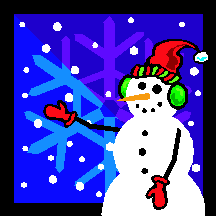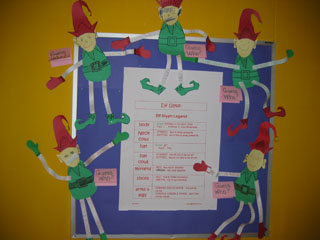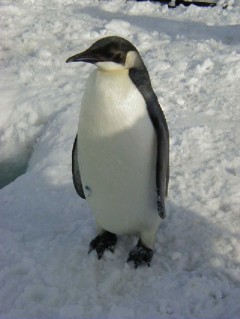
Winter Topics
Featured Activity: Elf Glyph
Glyphs are a fun way to add data collection activities to the math curriculum. Creative teachers adapt seasonal and holiday craft projects to glyph activities. This elf glyph comes complete with legend and patterns for easy assembly by students.


- Modifications: There are many elements of the design (belt, buckle, face) that were not included in the glyph legend. Please feel free to add these or to modify or omit any of the suggested glyph legend items to personalize the experience for your students.
- Although this activity was designed as a holiday glyph, the elf glyph could easily be modified for use with "The Elves and the Shoemaker" story as well simply by changing the colors and legend choices. Look for this version to follow shortly!
- Download Elf Glyph Legend.
- Download Elf Patterns
- Test your data analysis skills:
- Based on the Elf Glyph Legend, what do you know about the person who made this elf?


Mrs. Bestle's class at Port Monmouth Road School in Keansburg, NJ, made elf glyphs to display on the hall bulletin board. They challenged other students to guess who was who.

Penguin Math
Build on students' natural fascination with penguins by including these math pattern activities:
-
 Penguin Fishing challenges students to identify the pattern in the number of fish the penguin catches each day, write a rule for the number of fish the penguin catches based on the day, then use that rule and pattern to predict how many fish the penguin will catch on each of the next three days.
Penguin Fishing challenges students to identify the pattern in the number of fish the penguin catches each day, write a rule for the number of fish the penguin catches based on the day, then use that rule and pattern to predict how many fish the penguin will catch on each of the next three days.
-
 Capture the Penguins Game uses outcome of two-dice toss to form a coordinate pair. Student captures a penguin if there is one on that coordinate.
Capture the Penguins Game uses outcome of two-dice toss to form a coordinate pair. Student captures a penguin if there is one on that coordinate.
- Play FunBrain's
 Penguin Waiter to practice using percents to compute the correct tip for dinner checks. Four levels of difficulty make it possible to meet the varied needs of learners in a class.
Penguin Waiter to practice using percents to compute the correct tip for dinner checks. Four levels of difficulty make it possible to meet the varied needs of learners in a class.
- See
 Penguin Links for more information about penguins and their habitats.
Penguin Links for more information about penguins and their habitats.
Math-Literature Connections: Penguins

Penguin Measurement:
- Read the book Tacky the Penguin by Helen Lester as an introduction to penguin math activities.
-
 Measuring Penguins describes activity in which kindergarten students use linking cubes to measure life-size penguin cutouts.
Measuring Penguins describes activity in which kindergarten students use linking cubes to measure life-size penguin cutouts.
-
 Where in the World Is Tacky the Penguin? encourages students to measure distances in penguin feet.
Where in the World Is Tacky the Penguin? encourages students to measure distances in penguin feet.
-
 Sizing Up Penguins Webquest
Sizing Up Penguins Webquest
- Sing
 All the Penguins Song to introduce penguin measuring activities.
All the Penguins Song to introduce penguin measuring activities.

Winter Coordinate Graphing Games:
- Download the
 Capture the Penguins Game: students toss two dice (one regular and one A-F) in this fun game that introduces students to coordinate graphing in the spaces. Students form a coordinate pair based on the dice toss and capture a penguin, if possible. If the space holds a penguin, they capture the penguin for quick points. Create A-F dice using plain dice or purchase small wooden cubes at a craft store to make the dice. PDF contains game mat, directions, penguin markers and recording sheet.
Capture the Penguins Game: students toss two dice (one regular and one A-F) in this fun game that introduces students to coordinate graphing in the spaces. Students form a coordinate pair based on the dice toss and capture a penguin, if possible. If the space holds a penguin, they capture the penguin for quick points. Create A-F dice using plain dice or purchase small wooden cubes at a craft store to make the dice. PDF contains game mat, directions, penguin markers and recording sheet.
- Penguins pictured to the right were created by painting wooden clothespins and doll stands, both readily available at craft stores.
- Download the
 Grab the Candy Game: students toss two dice to form a coordinate pair then grab the candy on that space, if there is one. PDF contains game mat, directions and recording sheet.
Grab the Candy Game: students toss two dice to form a coordinate pair then grab the candy on that space, if there is one. PDF contains game mat, directions and recording sheet.

Snowflake Activities
Snowflake Studies describes the materials needed for students to "catch" snowflakes on black construction paper and view them through a magnifying glass to better appreciate the mathematical symmetry. The link also describes how to preserve snowflakes on glass slides for viewing under the microscope.
-
 Online directions for this activity
Online directions for this activity
- Download
 Directions for Folding and Cutting Hexagonal Snowflakes NOTE: Right-click link and save to your drive, then open.
Directions for Folding and Cutting Hexagonal Snowflakes NOTE: Right-click link and save to your drive, then open.
Math-Literature Connections: Snowflakes

Snowflake Photography: Learn about  Wilson Bentley, a Vermont photographer, famous for his snowflake images.
Wilson Bentley, a Vermont photographer, famous for his snowflake images.
- Read the book
 Snowflake Bentley, a Caldecott Medal Book written by Jacqueline Briggs Martin. The author's site includes additional resources and links for the book.
Snowflake Bentley, a Caldecott Medal Book written by Jacqueline Briggs Martin. The author's site includes additional resources and links for the book.
- Create your own virtual Snowflake.
- Download
 Directions and patterns for creating intricate snowflakes.
Directions and patterns for creating intricate snowflakes.
-
 Draw a Snowflake using Word or PowerPoint: directions for creating original hexagonal snowflakes using the draw tools.
Draw a Snowflake using Word or PowerPoint: directions for creating original hexagonal snowflakes using the draw tools.
- Print out
 Snowflake Cards to use for winter number recognition and counting activities or create a winter memory game deck.
Snowflake Cards to use for winter number recognition and counting activities or create a winter memory game deck.
- Place the
 Snowflake Board Game in the math center to provide young students with practice counting and moving that many spaces as they race toward home to win the game.
Snowflake Board Game in the math center to provide young students with practice counting and moving that many spaces as they race toward home to win the game.

Winter Problem Solving
-
 Snowballsintroduces K/1st grade students to drawing simple pictures and writing a number sentence to solve a winter problem.
Snowballsintroduces K/1st grade students to drawing simple pictures and writing a number sentence to solve a winter problem.
-
 Winter Fun problems use snowmen to engage K/1st grade students in problem solving.
Winter Fun problems use snowmen to engage K/1st grade students in problem solving.
-
 Winter Patterns use snowmen, sleds and mittens to explore patterns.
Winter Patterns use snowmen, sleds and mittens to explore patterns.
-
 Penguin Fishing challenges students to identify the pattern in the number of fish the penguin catches each day, write a rule for the number of fish the penguin catches based on the day, then use that rule and pattern to predict how many fish the penguin will catch on each of the next three days.
Penguin Fishing challenges students to identify the pattern in the number of fish the penguin catches each day, write a rule for the number of fish the penguin catches based on the day, then use that rule and pattern to predict how many fish the penguin will catch on each of the next three days.
- Try the
 Gingerbread Man Combinations problem challenges students to figure out how many different gingerbread men can be created using an online website
Gingerbread Man Combinations problem challenges students to figure out how many different gingerbread men can be created using an online website  Gingerbread Man. Be sure to use calculators for this activity!
Gingerbread Man. Be sure to use calculators for this activity!
- Try the
 Gingerbread Man Bake Sale problem, a simpler version of the Gingerbread Man Combinations problem, which challenges students to figure out how many different gingerbread man cookies Ruby can make for the holiday bake sale.
Gingerbread Man Bake Sale problem, a simpler version of the Gingerbread Man Combinations problem, which challenges students to figure out how many different gingerbread man cookies Ruby can make for the holiday bake sale.
-
 Make a Snowman by selecting from the different options available on this interactive website to create a virtual snowman.
Make a Snowman by selecting from the different options available on this interactive website to create a virtual snowman.
- Solve
 Snowman Combinations which challenges students to figure out how many different snowmen can be made from the given materials choices.
Snowman Combinations which challenges students to figure out how many different snowmen can be made from the given materials choices.

Winter Glyphs
Glyphs are a pictorial form of data collection. You might be reminded of the term "hieroglyphics" and think about early picture writing. Different forms of glyphs are used in many medical situations to quickly record data about a patient in pictorial form. For example, a dentist records cavities on a picture of teeth. A chiropractor might record injuries or muscle aches on a skeletal picture. In these cases, a "picture is worth a thousand words" and the glyph allows a doctor to more quickly record and analyze the data.
Students in elementary school often create paper art projects for different seasons or holidays. It is easy to transform these traditional projects into mathematical glyphs that allow students to organize and analyze data over several visits.
- Elf Glyph: New and original to Mathwire.com!
-
 Penguin Glyph
Penguin Glyph
-
 Penguin Printout to use in creating your own glyph legend.
Penguin Printout to use in creating your own glyph legend.
-
 Snowman Glyph
Snowman Glyph
-
 Easy Snowman Glyph
Easy Snowman Glyph
-
 Snowperson Glyph
Snowperson Glyph
-
 Reindeer Glyph
Reindeer Glyph
-
 Reindeer Glyph Legend
Reindeer Glyph Legend
-
 Gingerbread Glyph
Gingerbread Glyph
-
 Gingerbread Glyph and other math measurement ideas using gingerbread man theme.
Gingerbread Glyph and other math measurement ideas using gingerbread man theme.
-
 Mitten Glyph legend
Mitten Glyph legend
- See Glyphs to learn more about glyphs, view student samples or for links to glyph activities on the internet.




Additional Seasonal Math Activities
These math activities are organized by seasons. Elementary teachers often incorporate seasonal activities as craft projects. Many of these seasonal craft projects can be mathematical as well with a little forethought. Browse the activities for projects to add that reinforce mathematical concepts and skills through seasonal and holiday themes.
- Fall into Math for fall and Halloween math activities [Fall 2005]
- Fall Math Activities for fall and Halloween math activities [Fall 2006]
- Winter Math Activities for winter and holiday math activities [Winter 2005]
- February Math Activities for Valentine's Day and Winter Olympics activities [February 2006]
- See all Mathwire Seasonal Math Activities
